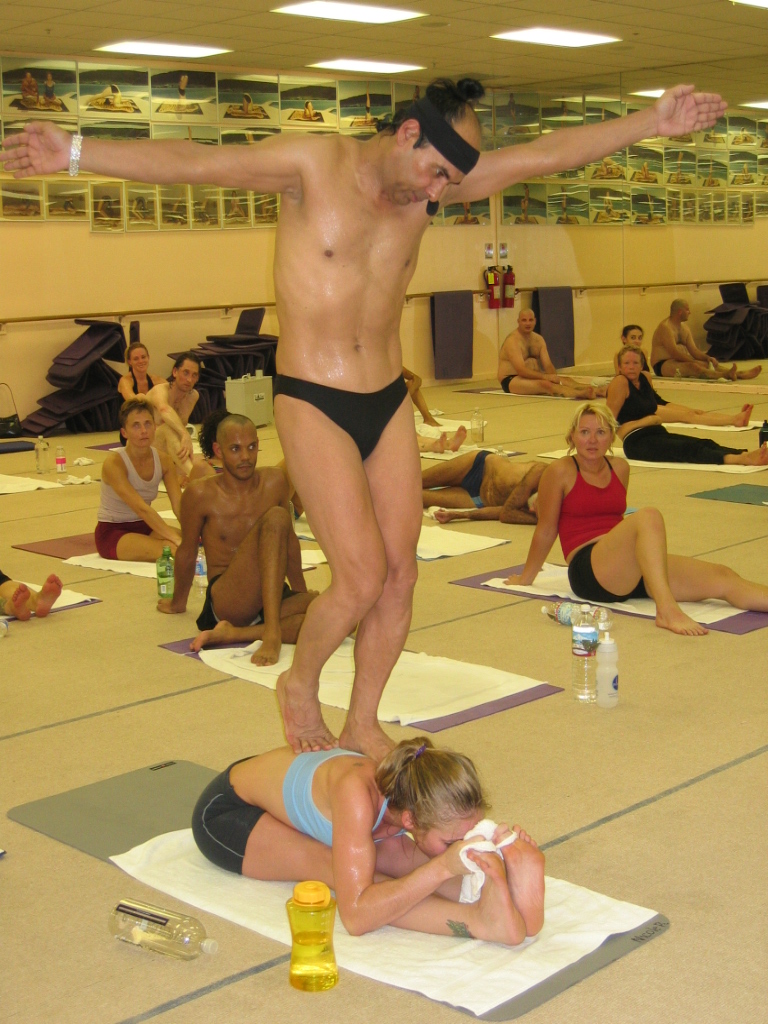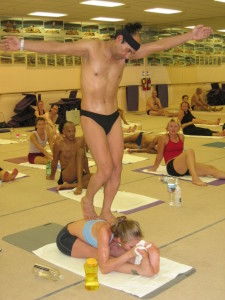Some Like it Hot — Hot Yoga Explained


I’ve had a number of people ask me what Hot Yoga is all about. I thought it might be good to post the information here, so I can refer back to this article when the question comes up again. I’d like to explain the difference between Bikram and Hot Yoga, and give my personal insight on whether there are any unique benefits to this form of yoga.
Bikram Choudhury is essentially the inventor of the concept of “Hot Yoga”, but his method is more specifically referred to as “Bikram Yoga”, to distinguish it from the many other “Hot Yoga” offerings you see blowing up all over the U.S. at various studios. He founded the Yoga College of India in Beverly Hills in 1974. Bikram Yoga involves the same series of 26 yoga poses and several breath exercises, performed twice in a 90 minute time frame in a room heated to 105 degrees/40 percent humidity. My theory is that he came up with this concept based on practicing yoga in the sweltering heat of India. Bikram filed a lawsuit some time ago against some Bay Area studios offering “Hot Yoga”. It seems that he has agreed to allow the use of the term “Hot Yoga” (or it’s simply not something he can exclusively copyright).
To be fair, I have not attended a Bikram class, but don’t plan to, based on reports from students. I do not want to be in crowded class with someone yelling at me on a headset, doing the same poses every time. The Bikram-trained instructors are supposed to give the exact same verbal instruction each time. A friend who took a class from Birkam himself said he literally sits on a throne and will insult you personally. (Note: Friends who have practiced in India say the insults are a “typical Indian thing”, but it doesn’t sound motivating to me. Perhaps amusing at best.) However, let me make it clear it’s not my thing to bash on other studios! Some people really enjoy the militaristic aspects of the class. I’ve been told that busy, “Type A” LA film executives who make decisions all day would rather be submissive and told what to do. If you are getting something great out of ANY yoga studio you attend, I salute you.
Now, “Hot Yoga” classes are also performed in a heated room. But the similarities end there. The temperature of the room may vary. Some studios may simply have a heated room with their own yoga sequences, others may try to emulate Bikram’s approach. Unless they use exact wording/approach and get official certification from him, opening an actual Bikram franchise, they can only call it the more generic “Hot Yoga”. You won’t really know exactly what you’re going to get until you attend a Hot Yoga class at that particular yoga studio. A “Hot Yoga” class at one studio could be dramatically different from one at another studio in terms of approach and degree of heat.
I think the heat/sweat just gives practitioners a sense of accomplishment. There is not enough scientific/medical proof out there that you are “detoxing”. In fact, analysis of sweat shows that very little “detox” materials come out in the sweat.
What do I think about Hot Yoga? I’ve attended about half a dozen such classes, and it’s generally not for me. This is why I don’t subscribe to the Hot Yoga Tribe:
- Every studio is unique, but I always witness more vanity and competition in these types of classes. Not my thing.
- The extreme heat usually leaves me depleted, not refreshed or energized. I have experienced, witnessed or read about people having to leave the room to throw up. And please don’t make me give you details about gatsrointestinal reactions. Read this blog post if you dare.
- As a teacher, I’m concerned about the idea people have that they can go more deeply into poses because their “muscles are warm”. Just because the room is warm doesn’t mean your muscles themselves are warm, or that you can significantly advance beyond your usual limits. Be sure to prepare carefully before doing more advanced poses. Warming up means starting with gentler, simpler poses to open up the body. My husband’s friend hurt his shoulder badly and had to drop out of classes for a couple weeks. (Overdoing it is common in all types of classes, however.)
- I have slipped on the wet mat or seen other people slip. Dangerous. I know there are special mats and hot yoga towels to help prevent against such things, but it’s something to consider. Towels on top of mats can tend to get bunched up and create instability.
- I have stepped in or been sprayed by someone else’s sweat. And especially during cold/flu season, the whole notion of sharing sweat just seems gross to me. Make sure your hot yoga studio uses the right kind of flooring that is hypo-allergenic and able to handle the heat and humidity. And use your own mat! Even if they say they clean the mats. (I recommend this at any studio).
- Even though any credible studio will advise you to hydrate properly, some people don’t have the best judgment about this…so please be careful. You will start sweating buckets as soon as you walk in the room and roll out your mat. I have never seen any scientific proof that Hot Yoga “sweats out the toxins”. It has been documented that when you’re hungover, sweating a lot will help any remaining alcohol in your system evaporate, so perhaps Hot Yoga would be a good post-partying workout. I think any benefits from sweating through a Hot Yoga class are largely perceived. There is psychological satisfaction to it for some people, which is different than legitimately proven physiological benefits.
My final verdict: I prefer a yoga class that offers a little something “in between”. I program my classes to have about a 20 minute “arch” in the middle (after warm up and before cool down), in which we’re doing more vigorous vinyasa and strength poses like warrior 3. We sweat enough to require dabs with a hand towel. I also certainly don’t like a freezing yoga room (even in sunny Cali, I’ve either practiced or taught on a chilly wood floor. Brrrrrrr!) Of course, I can’t stand a cold floor and then big vents pouring down heat on to me from the ceiling, making my face and eyes feel dry. At our own studio in 2011, we considered investing in a heated floor, so that the room was moderately warm and comfortable to practice in, but we had no complaints from customers. Based on the environment of our space at any given time and feedback of the students, we turned up the heat as needed.
We did a good job breaking a sweat from the poses alone! 🙂 As you deepen in your practice of yoga, you can learn more about how to trigger your own agni (fire) without needing an extremely hot space.
McKenna Rowe is the Founder of Chakra 5 Mobile Yoga, an experienced team of corporate yoga instructors that provides mobile yoga classes on location and by appointment at businesses, schools and organizations throughout greater Los Angeles. Call us to start your corporate wellness program today: 310-853-3885.
